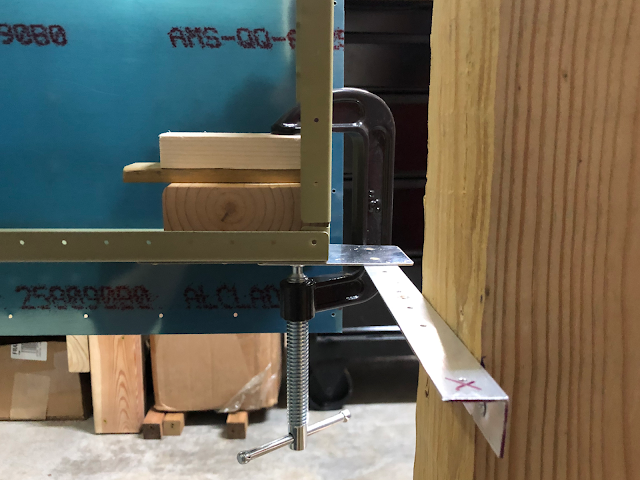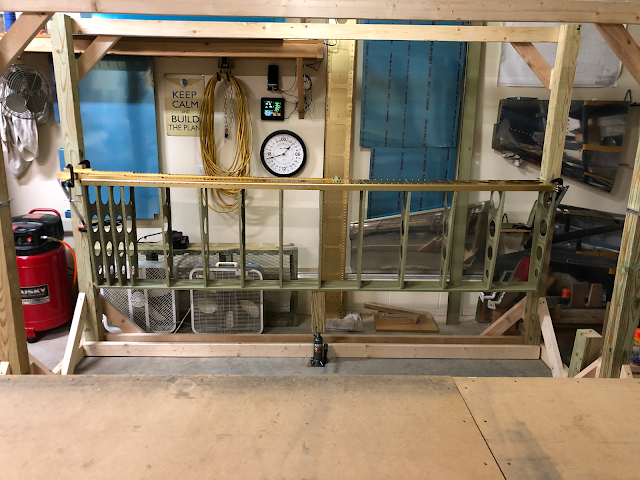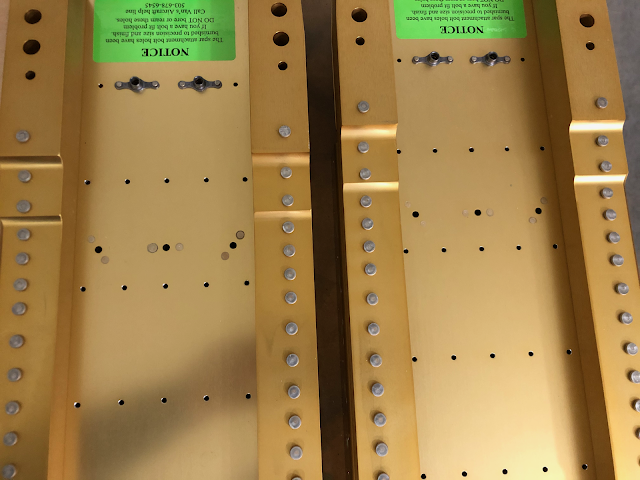Per the plans, I grabbed some scrap MDF from the garage, screwed a couple pieces together, and cut out the shape of the leading edge ribs to use as a cradle. Add a couple of 2x4s and the cradle is ready to go.
I took the right leading edge skin and lowered it into the cradle. Getting the ribs clecoed in was no easy task. Just like on the empennage, the skins here are stretched super tightly over the ribs, so there's little room for error.
After a little coaxing (and as had become usual, a bit of cursing) I was able to get clecos into every rib.
I took the assembly out of its cradle and set it into place on the wing. Even without the clecos to hold it onto the spar it slid right into place and fit pretty much perfectly. I clecoed the ribs to the spar, but I ran into an issue when I went to cleco the skin to the spar flange.
The tiedown bracket, which I had moved further down to keep there from being a gap between the bracket and the leading edge skin, was doing too good a job and was keeping the skin from lying flat against the spar.
My error was using a perfectly flat piece of aluminum against the spar flange to position the brackets when the leading edge skin actually curves inward here. If I'd had the foresight to do so then I would have test fitted the bracket with the curved skin before drilling.
 |
| No bueno. |
Ah well, no big deal. A few minutes with the scotchbrite wheel to shape the bracket and now it fits.
 |
| Mucho mejor. |
Now that things were fitting well I put in all of the skin the spar flange clecos to get the leading edge fully attached. Once all the clecos were in I grabbed the 12-inch #30 bit to back drill all of the ribs. The bit is sharp so it doesn't take very long, but getting the bit lined up perpendicular to the spar takes a bit of patience.
Moving on, the hole for the tiedown ring is too small and needs to be enlarged to accept the ring itself, so that became my next task. The plans state that this hole is supposed to be perfectly centered but my be a little off from project to project. I enlarged the hole just slightly so I could get a good look inside and was pleasantly surprised to find that the hole was indeed perfectly centered for me.
 |
| The verical line was an attempt to locate the center of the tiedown bracket before drilling. Good thing I didn't use it since it's completely wrong! |
After using the unibit to enlarge the hole I went to test it with the stainless steel tiedown rings I bought from Cleaveland. I was having trouble getting the ring to thread into the bracket when I realized that the hole in the skin was actually too small for the ring. I'll need to enlarge the hole a bit more after the skin is removed from the skeleton since the tiedown bracket won't allow the hole to be made any bigger with it in place.
I moved on to the W-408 rib, which is the most inboard leading edge rib that I skipped earlier since it's blank. I deburred the edges and marked the centerline of the aft flange before slipping it into place in the side of the leading edge skin. The rib is horribly warped from the forming process, so I used a sharpie to mark where each hole will line up so I could flute the rib in between the holes.
With the rib fluted I had a much better time getting it in its proper place. I carefully lined up the line I had marked earlier with the holes in the web of the spar, then I used the 12-inch #30 bit to match drill the holes in the aft flange of the rib. The results were acceptable.
 |
| ...and by acceptable, I mean near-perfect. Carefulness pays off! |
Before I could match drill the holes into the rest of the rib flange, I needed to fabricate the joint plate that will allow the fuel tank to attach to the leading edge. Van's includes a couple of aluminum strips that are already cut to size, so all I had to do was bend one in the shape of the rib so it could be slid into place.
Bending the strip was easy. Getting it into place was not.
It took nearly 30 minutes of trial and error to get the strip wedged in place between the skin and the rib. The strip isn't perfectly shaped to the curve of the rib and the skin so there's interference near the front of the leading edge that required a good amount of coaxing and force to overcome.
 |
| This is exactly what I was after: 11/16" of the joint plate exposed on both the top and the bottom. It took a while to get to this point... |
Moving the tightly-wedged strip tends to also move the rib, meaning it was difficult getting the strip to match the dimensions called out in the plans while also making sure the rib didn't move out of its proper place. The last thing I want is for the rib to end up with holes that don't have minimum edge distance, so I agonized over getting everything as close to perfect as I could.
Eventually though, everything was in place. I could finally take a step back and start getting an idea of the scale of the finished wing.





















































